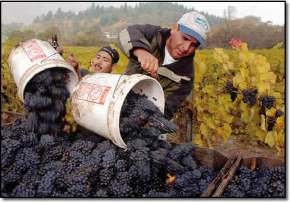|
On The Grapevine, May 2012
Bro Mike , Wine Correspondant
We love to talk about the weather. It’s a safe topic. A little dull perhaps, but safe. And in the last couple of years there’s been a lot of it to talk about, just in Australia there has been the scorching hot summers of 2007 and 2009, drought or near drought conditions lasting for more than 10 years and the record floods of 2011 and 2012. It seems that the global weather system is getting weirder and less predictable. Has the human impact on the environment finally screwed our weather up once and for all? This brings us round to the contentious but important subject of global warming, and its potential impact on viticulture.
Important new data suggests that the impact of global warming on many of the world’s leading wine regions may have already had a major influence on wine quality, and will likely have further significant effects in the near future.
Recently, a research study in the U.S. reported results of their analysis of 50 years of climate data from 27 different wine regions around the world and compared them with Sotheby’s 100-point wine grape vintage ratings, looking for any trends in wine quality and growing season temperatures. In addition, it ran a sophisticated climate model to look at the projected temperature changes over the next 50 years.
The results are quite striking. Overall, growing season temperatures have increased for most of the world’s high quality wine regions over the last 50 years, by an average of 2ºC. In tandem with this rise in temperatures, the quality of vintages has also improved over this period. The study showed a significant relationship between the vintage ratings and monthly average growing season temperatures in most regions.
One potential confounder is that winemaking and viticulture has improved quite dramatically over the last 50 years with the result that what would have been a disastrous vintage some decades ago is now salvageable. In addition, because of the rise in prices of fine wines, producers can afford to be more selective, declassifying where necessary – the result is that the overall quality perception of a difficult vintage is improved. As a result, there is the chance that the rise in vintage quality caused by these changes could be mistakenly attributed to the temperature increases. The research accepts this, but points out that results show that 10–60% of vintage quality can be explained by growing season temperature variability, with the greatest effects seen in cool climate regions such as the Mosel, in Germany.
The data also indicates that for many regions, climate has become more variable over this 50 year period, showing that more than half the regions experienced changes in growing season temperature variability. These changes in variability were not uniform, with most of the European regions having the greatest changes. Given that the weather towards the end of the growing season, around harvest time, is crucial for vintage quality, the study found that the relative temperature changes in the ripening window mirrored those of the rest of the growing season for most of the regions.
Perhaps the most interesting part of the study concerns its predictions for the next 50 years. To look into the future the study coupled with the atmosphere– ocean general circulation model, which has been used previously for predicting changes in agricultural conditions. The results suggest that the 27 wine regions analysed can expect a further average growing season temperature increase around 2ºC by 2050. Of these regions, the largest predicted change was for southern Portugal (2.9ºC) the lowest was for South Africa (0.9ºC).
While a change of 2ºC doesn’t sound very dramatic, averaged over a growing season this sort of temperature increase is significant. From the research it would appear that the currently cool climate regions would benefit the most. If the climate warms as the models predict, then these regions will be better able to ripen the fruit and may even be able to consider other varieties that could not ripen there today. In Australia it suggests that this might be good news for wineries in southern Victoria and Tasmania but bad news for areas like the Hunter Valley. In addition, warmer temperatures could lead to new areas opening up to viticulture around the world.
The news is less encouraging for some of the warmest wine regions. For many of the warm to hot regions, the negative impacts are already being felt. In hot regions, grapes ripen to a “sugar ripe” condition, but lack flavours that can take time to develop. Other regions, somewhat in between cool to hot growing climates, will likely have to consider other varieties that will produce better quality wines in a new climate regime. For example, in California’s Napa and Sonoma Valleys, the climate has become so warm that ripening fruit is not an issue, but retaining acidity and developing flavour have become increasingly difficult in the warmer conditions. The analysis shows that this issue could become very critical in already warm areas like Chianti and Barolo in Italy, Rioja in Spain, southern France, the Hunter Valley, parts of Chile and the Central Valley of California.
Other effects of increased temperatures could include harvest periods being brought forward into the warmest parts of the year, reduced water availability, and increased pest and disease burden particularly, with increased humidity.
So while it seems that the climate change over the last 50 years has mostly had a positive effect on wine quality across the 27 regions included in the U.S. study, the future picture could be quite different. And assuming that the projections from the climate models are at all accurate, viticulturalists across the globe will have their work cut out adapting their vineyards to take account of these changes. |
|
|




